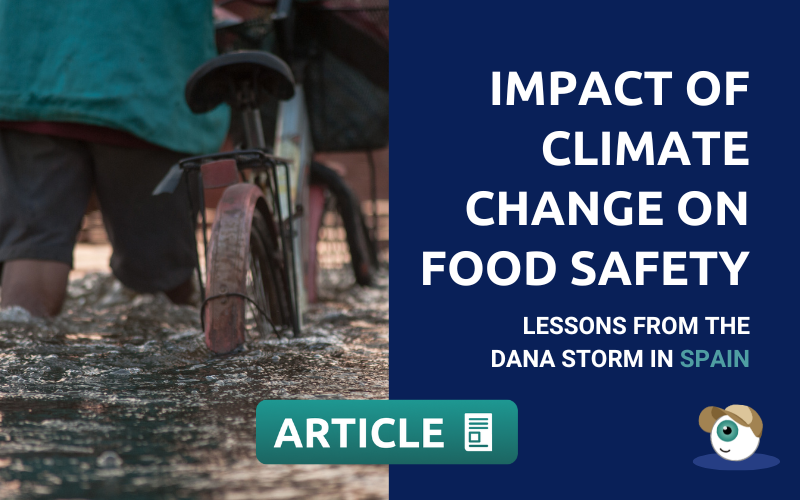The Impact of Climate Change on Food Safety: Lessons from the DANA Storm in Spain

Last week, the DANA storm swept across eastern and southern Spain, leaving a trail of destruction and grief in its path.
Extreme rainfalls triggered catastrophic flooding, causing extensive damage to infrastructure, food supplies, and essential services.
The tragic loss of lives and livelihoods has underscored the vulnerability of our communities in the face of these increasingly intense weather events.
For those in the food industry, DANA serves as a sobering reminder of the growing challenges climate change presents to food safety.
In this article, we explore the worrying impact of climate change on food safety and the measures that we all need to start taking to minimise its effects on our businesses and lives.
The Immediate Impact of Climate Change on Food Safety
Flooding can wreak havoc on food safety.
As seen in Spain in October 2024, the heavy rains led to power outages and water supply disruptions, both of which are critical for maintaining safe food environments.
These conditions pose serious risks:
Contamination: Floodwaters are often contaminated with bacteria, chemicals, and debris, making any exposed food unsafe for consumption. Even packaged foods can be compromised if they come into contact with floodwater. This contamination can spread rapidly, affecting large quantities of food and causing significant health hazards.
Temperature Control: Extended power outages disrupt refrigeration, causing perishable foods to reach unsafe temperatures and creating ideal conditions for bacterial growth. This not only leads to increased food spoilage but also heightens the risk of foodborne illnesses such as salmonella and listeria, which thrive in warm conditions when food is not stored properly.
Access to Safe Water: When water infrastructure is compromised, food establishments lack the clean water necessary for food preparation, cleaning, and sanitation, increasing the risk of foodborne illness. Safe water is essential for washing produce, cooking, and cleaning utensils and surfaces. Without it, the possibility of cross-contamination and the spread of pathogens rises significantly.
Logistical Challenges: The destruction of roads and infrastructure further complicates the delivery of fresh produce and other food supplies. This disruption in the supply chain can lead to shortages and force food service providers to rely on less fresh or lower quality ingredients, which may not meet safety standards.
Employee Well-being: The well-being of employees is also a concern during such disasters. Staff may face difficulties in commuting, health risks from contaminated environments, and increased stress levels due to the urgency of restoring safe operations. Ensuring that employees are safe and supported is crucial for maintaining food safety standards.
In response to these challenges, food service establishments in the affected areas have worked tirelessly to dispose of compromised stock, sanitise equipment, and secure safe water sources to restore operations safely.
However, as climate-driven events like DANA become more common, these emergency responses need to evolve.
Enhanced training, better infrastructure planning, and stronger community support systems will be vital in building resilience against future climate impacts.

Climate Change: A Growing Threat to Food Safety
Climate change intensifies extreme weather events, including storms, floods, heatwaves, and droughts, which directly impact food safety in multiple ways.
As these phenomena become more frequent and severe, the food service industry faces significant challenges in maintaining safety and quality standards.
Increased Food Spoilage and Waste
Unstable weather patterns lead to frequent power outages and infrastructure damage, as evidenced by DANA.
These disruptions compromise cooling and storage conditions, causing food products to spoil more quickly. The result is not only significant economic losses but also increased food waste, which further exacerbates environmental concerns.
Water Quality Issues
With the advent of climate change, heavy rains and flooding have become more frequent, often contaminating natural water sources with harmful bacteria, chemicals, and pathogens.
Poor water quality affects all stages of the food production cycle, from irrigation to cleaning, preparation, and sanitation within food service establishments. Ensuring access to clean, safe water is crucial to prevent the spread of foodborne illnesses.
Pests and Diseases
Warmer climates and shifting weather patterns contribute to the proliferation of pests and diseases in both agriculture and food storage.
Increased pest activity can introduce contaminants and allergens, posing significant health risks to consumers.
Effective pest management and disease control measures are essential to protect food safety and quality.
Supply Chain Vulnerabilities
Climate change disrupts food supply chains, making it increasingly difficult for food service providers to access fresh ingredients or maintain consistent inventories. Unpredictable weather can lead to shortages, higher prices, and reduced quality in food products.
To mitigate these risks, it is vital to develop resilient supply chain strategies and establish contingency plans.
By understanding and addressing these threats, the food service industry can better prepare for the challenges posed by climate change, ensuring the safety and well-being of consumers.
Building Resilience in Food Safety Practices
In light of these growing climate threats, the food service industry must take proactive steps to protect food safety and maintain resilience.

Here are some enhanced strategies to consider:
Enhanced Contingency Planning
- Develop comprehensive crisis response plans: These plans should include detailed protocols for managing power outages, water shortages, and equipment failures. Regular drills and training sessions for staff are essential to ensure quick and effective action during emergencies.
- Risk Assessments: Conduct frequent risk assessments to identify potential vulnerabilities and update contingency plans accordingly. This practice ensures preparedness for new and emerging threats.
Infrastructure Investment
- Backup Power Sources: Invest in robust backup power solutions, such as generators and uninterruptible power supplies (UPS), to maintain refrigeration and other critical systems during power outages.
- Water Filtration and Storage: Install advanced water filtration systems and consider setting up water storage facilities to ensure a continuous supply of clean and safe water during extreme weather events.
- Resilient Building Design: Upgrade facilities to withstand extreme weather conditions, such as reinforcing structures and installing flood barriers.
Improved Supply Chain Flexibility
- Diverse Supplier Network: Establish relationships with multiple suppliers and create contingency agreements to secure alternative sources of food and resources. This approach minimizes the impact of supply chain disruptions and ensures a steady flow of essential items.
- Local Sourcing: Emphasise local sourcing to reduce dependency on long-distance supply chains that may be more vulnerable to climate-related disruptions.
- Inventory Management: Implement advanced inventory management systems to better predict demand and manage stock levels efficiently, reducing waste and ensuring availability during supply shortages.
Community Collaboration
- Engage with Local Authorities: Work closely with local governments to develop collaborative response plans, ensuring a coordinated approach to food safety during extreme events.
- Shared Resources: Partner with neighbouring businesses and community organizations to share resources, such as backup power and water supplies, to enhance collective resilience.
- Public Awareness Campaigns: Launch public awareness initiatives to educate the community about the importance of food safety and the steps they can take during extreme weather events.
By implementing these strategies, the food service industry can better prepare for the challenges posed by climate change, ensuring the safety and well-being of consumers.
The Path Forward
The recent DANA storm in Spain is yet another reminder of how climate change is shaping our future and the critical need for a resilient, adaptable food system.
As weather events become more intense and frequent, the food industry’s commitment to food safety becomes even more essential.
By preparing for these risks today, we can help protect the health of our communities and contribute to a more sustainable food future.
At Andy, we’re committed to supporting the food service industry in facing the new challenges that the impact of climate change on food safety will surely bring..
Stay tuned to our blog for resources and updates on climate resilience and food safety.
👉🏽START YOUR FREE TRIAL TODAY👈🏽


